Evaluation of Synoptic Snowfall on the Antarctic Ice Sheet Based on CloudSat, In-Situ Observations and Atmospheric Reanalysis Datasets
Abstract
:1. Introduction
2. Materials and Methods
2.1. CloudSat Data
2.2. Synoptic CloudSat Snowfall
2.3. AWS Data
2.4. Reanalysis Data
3. Results
3.1. Time Series of Snowfall and Snow Accumulation
3.2. Synoptic Comparison between Extreme Events
3.3. Snowfall over the AIS
4. Conclusions and Discussion
Author Contributions
Funding
Acknowledgments
Conflicts of Interest
References
- Forsberg, R.; Sørensen, L.; Simonsen, S. Greenland and Antarctica Ice Sheet Mass Changes and Effects on Global Sea Level. Surv. Geophys. 2017, 38, 89–104. [Google Scholar] [CrossRef] [Green Version]
- Wouters, B.; Bamber, J.L.; van den Broeke, M.R.; Lenaerts, J.T.M.; Sasgen, I. Limits in detecting acceleration of ice sheet mass loss due to climate variability. Nat. Geosci. 2013, 6, 613–616. [Google Scholar] [CrossRef]
- Turner, J.; Phillips, T.; Thamban, M.; Rahaman, W.; Marshall, G.J.; Wille, J.D.; Favier, V.; Winton, V.H.; Thomas, E.; Wang, Z.; et al. The dominant role of extreme precipitation events in Antarctic snowfall variability. Geophys. Res. Lett. 2019, 46. [Google Scholar] [CrossRef]
- Gorodetskaya, I.V.; Kneifel, S.; Maahn, M.; Van Tricht, K.; Thiery, W.; Schween, J.H.; Mangold, A.; Crewell, S.; van Lipzig, N.P.M. Cloud and precipitation properties from ground-based remote-sensing instruments in East Antarctica. Cryosphere 2015, 9, 285–304. [Google Scholar] [CrossRef] [Green Version]
- Souverijns, N.; Gossart, A.; Gorodetskaya, I.V.; Lhermitte, S.; Mangold, A.; Laffineur, Q.; Delcloo, A.; Van Lipzig, N.P.M. How does the ice sheet surface mass balance relate to snowfall? Insights from a ground-based precipitation radar in East Antarctica. Cryosphere 2018, 12, 1987–2003. [Google Scholar] [CrossRef] [Green Version]
- Bromwich, D.H. Snowfall in high southern latitudes. Rev. Geophys. 1988, 26, 149–168. [Google Scholar] [CrossRef] [Green Version]
- Lawson, R.P.; Baker, B.A.; Zmarzly, P.; O’Connor, D.C.; Mo, Q.; Gayet, J.F.; Shcherbakov, V. Microphysical and optical properties of atmospheric ice crystals at south pole station. J. Appl. Meteorol. Clim. 2006, 45, 1505–1524. [Google Scholar] [CrossRef]
- Walden, V.P.; Warren, S.; Tuttle, E. Atmospheric ice crystals over the Antarctic Plateau in winter. J. Appl. Meteorol. Clim. 2003, 42, 1391–1405. [Google Scholar] [CrossRef]
- Stephens, G.L.; Vane, D.G.; Tanelli, S.; Im, E.; Durden, S.; Rokey, M.; Reinke, D.; Partain, P.; Mace, G.G.; Austin, R.; et al. CloudSat mission: Performance and early science after the first year of operation. J. Geophys. Res.-Atmos. 2008, 113. [Google Scholar] [CrossRef]
- Liu, G. Deriving snow cloud characteristics from CloudSat observations. J. Geophys. Res. 2008, 113. [Google Scholar] [CrossRef] [Green Version]
- Casella, D.; Panegrossi, G.; Sanò, P.; Marra, A.C.; Dietrich, S.; Johnson, B.T.; Kulie, M.S. Evaluation of the GPM-DPR snowfall detection capability: Comparison with CloudSat-CPR. Atmos. Res. 2017, 197, 64–75. [Google Scholar] [CrossRef]
- Wood, N.B. Estimation of Snow Microphysical Properties with Application to Millimeter-Wavelength Radar Retrievals for Snowfall Rate. Ph.D. Thesis, Colorado State University, Fort Collins, CO, USA, 2011. [Google Scholar]
- Boening, C.; Lebsock, M.; Landerer, F.; Stephens, G. Snowfall-driven mass change on the East Antarctic Ice Sheet. Geophys. Res. Lett. 2012, 39. [Google Scholar] [CrossRef]
- Palerme, C.; Kay, J.E.; Genthon, C.; L’Ecuyer, T.; Wood, N.B.; Claud, C. How much snow falls on the Antarctic ice sheet? Cryosphere 2014, 8, 1577–1587. [Google Scholar] [CrossRef] [Green Version]
- Kulie, M.S.; Milani, L.; Wood, N.B.; Tushaus, S.; Bennartz, R.; L’Ecuyer, T.S. A shallow cumuliform snowfall census using spaceborne radar. J. Hydrometeorol. 2016, 17, 1261–1279. [Google Scholar] [CrossRef]
- Kulie, M.S.; Milani, L. Seasonal variability of shallow cumuliform snowfall: A CloudSat perspective. Q. J. R. Meteorol. Soc. 2018, 144. [Google Scholar] [CrossRef]
- Milani, L.; Kulie, M.S.; Daniele, C.; Stefano, D.; L’Ecuyer Tristan, S.; Giulia, P. CloudSat snowfall estimates over antarctica and the southern ocean: An assessment of independent retrieval methodologies and multi-year snowfall analysis. Atmos. Res. 2018, 213, 121–135. [Google Scholar] [CrossRef]
- Lemonnier, F.; Madeleine, J.-B.; Claud, C.; Genthon, C.; Durán-Alarcón, C.; Palerme, C.; Berne, A.; Souverijns, N.; Lipzig, N.; Gorodetskaya, I.V.; et al. Evaluation of CloudSat snowfall rate profiles by a comparison with in-situ micro rain radars observations in East Antarctica. Cryosphere 2019, 13, 943–954. [Google Scholar] [CrossRef]
- Souverijns, N.; Gossart, A.; Lhermitte, S.; Gorodetskaya, I.V.; Grazioli, J.; Berne, A.; Duran-Alarcon, C.; Boudevillain, B.; Genthon, C.; Scarchilli, C.; et al. Evaluation of the CloudSat surface snowfall product over Antarctica using ground-based precipitation radars. Cryosphere 2018, 12, 3775–3789. [Google Scholar] [CrossRef] [Green Version]
- Palerme, C.; Genthon, C.; Claud, C.; Kay, J.E.; Wood, N.B.; L’Ecuyer, T. Evaluation of current and projected Antarctic precipitation in CMIP5 models. Clim. Dynam. 2017, 48, 225–239. [Google Scholar] [CrossRef]
- Souverijns, N.; Gossart, A.; Lhermitte, S.; Gorodetskaya, I.V.; Kneifel, S.; Maahn, M.; Bliven, L.F.; van Lipzig, N.P.M. Estimating radar reflectivity-Snowfall rate relationships and their uncertainties over Antarctica by combining disdrometer and radar observations. Atmos. Res. 2017, 196. [Google Scholar] [CrossRef]
- Fountain, A.G.; Nylen, T.H.; Macclune, K.L.; Dana, G.L. Glacier mass balances (1993–2001), Taylor Valley, McMurdo Dry Valleys, Antarctica. J. Glaciol. 2006, 52, 451–462. [Google Scholar] [CrossRef]
- Reijmer, C.H.; van den Broeke, M.R. Temporal and spatial variability of the surface mass balance in Dronning Maud Land, Antarctica. J. Glaciol. 2003, 49, 512–520. [Google Scholar] [CrossRef]
- Bromwich, D.H.; Nicolas, J.P.; Monaghan, A.J. An assessment of precipitation changes over Antarctica and the Southern Ocean since 1989 in contemporary global reanalyses. J. Clim. 2011, 24, 4189–4209. [Google Scholar] [CrossRef]
- Cohen, L.; Dean, S. Snow on the Ross Ice Shelf: Comparison of reanalyses and observations from automatic weather stations. Cryosphere 2013, 7, 1399–1410. [Google Scholar] [CrossRef]
- Welker, C.; Martius, O.; Froidevaux, P.; Reijmer, C.H.; Fischer, H. A climatological analysis of high-precipitation events in Dronning Maud Land, Antarctica, and associated large-scale atmospheric conditions. J. Geophys. Res. 2014, 119, 11932–11954. [Google Scholar] [CrossRef]
- Monaghan, A.J.; Bromwich, D.H.; Fogt, R.L.; Wang, S.H.; Mayewski, P.A.; Dixon, D.A.; Ekaykin, A.; Frezzotti, M.; Goodwin, I.; Isaksson, E.; et al. Insignificant change in Antarctic snowfall since the International Geophysical Year. Science 2006, 313, 827–831. [Google Scholar] [CrossRef] [PubMed]
- Agosta, C.; Favier, V.; Genthon, C.; Gallée, H.; Krinner, G.; Lenaerts, J.T.M.; van den Broeke, M.R. A 40-year accumulation dataset for Adelie Land, Antarctica and its application for model validation. Clim. Dyn. 2012, 38, 75–86. [Google Scholar] [CrossRef]
- Medley, B.; Joughin, I.; Das, S.B.; Steig, E.J.; Conway, H.; Gogineni, S.; Criscitiello, A.S.; McConnell, J.R.; Smith, B.E.; van den Broeke, M.R.; et al. Airborne-radar and ice-core observations of annual snow accumulation over Thwaites Glacier, West Antarctica confirm the spatiotemporal variability of global and regional atmospheric models. Geophys. Res. Lett. 2013, 40, 3649–3654. [Google Scholar] [CrossRef] [Green Version]
- Trenberth, K.E.; Fasullo, J.T.; Mackaro, J. Atmospheric moisture transports from ocean to land and global energy flows in reanalyses. J. Clim. 2010, 24, 4907–4924. [Google Scholar] [CrossRef]
- Bosilovich, M.G.; Robertson, F.R.; Chen, J.Y. Global energy and water budgets in MERRA. J. Clim. 2011, 24, 5721–5739. [Google Scholar] [CrossRef]
- Hersbach, H.; de Rosnay, P.; Bell, B.; Schepers, D.; Simmons, A.; Soci, C.; Abdalla, S.; Alonso-Balmaseda, M.; Balsamo, G.; Bechtold, P.; et al. Operational global reanalysis: Progress, future directions and synergies with NWP. ERA Rep. Ser. 2018. [Google Scholar] [CrossRef]
- Dee, D.P.; Uppala, S.M.; Simmons, A.J.; Berrisford, P.; Kobayashi, P.; Andrae, S.; Alonso-Balmaseda, U.; Balsamo, M.; Bauer, G.; Bechtold, P.; et al. The ERA-Interim reanalysis: Configuration and performance of the data assimilation system. Q. J. R. Meteorol. Soc. 2011, 137, 553–597. [Google Scholar] [CrossRef]
- Stephens, G.L.; Vane, D.G.; Boain, R.J.; Mace, G.G.; Sassen, K.; Wang, Z.; Illingworth, A.J.; O’Connor, E.J.; Rossow, W.B.; Durden, S.L.; et al. The CloudSat Mission and the A-Train. Bull. Am. Meteorol. Soc. 2002, 83, 1771–1790. [Google Scholar] [CrossRef]
- Marchand, R.; Mace, G.G.; Ackerman, T.; Stephens, G. Hydrometeor Detection Using CloudSat-An Earth-Orbiting 94-GHz Cloud Radar. J. Atmos. Ocean. Technol. 2008, 25, 519–533. [Google Scholar] [CrossRef]
- Tanelli, S.; Durden, S.L.; Im, E.; Pak, K.S.; Reinke, D.G.; Partain, P.; Haynes, J.M.; Marchand, R.T. CloudSat’s cloud profiling radar after two years in orbit: Performance, calibration, and processing. IEEE Trans. Geosci. Remote Sens. 2008, 46, 3560–3573. [Google Scholar] [CrossRef]
- Partain, P. CloudSat ECMWF-AUX Auxiliary Data Process Description and Interface Control Document, Algorithm Version 5.2. Available online: http://www.cloudsat.cira.colostate.edu/sites/default/files/products/files/ECMWF-AUX_PDICD.P_R04.20070718.pdf (accessed on 3 December 2018).
- Ackerman, S.A.; Frey, R. MODIS Atmosphere L2 Cloud Mask Product (35_L2); NASA MODIS Adaptive Processing System, NASA Goddard Space Flight Center: Greenbelt, MD, USA, 2015. [Google Scholar] [CrossRef]
- Cooper, S.J.; Wood, N.B.; L’Ecuyer, T.S. A variational technique to estimate snowfall rate from coincident radar, snowflake, and fall-speed observations. Atmos. Meas. Tech. 2017, 10, 2557–2571. [Google Scholar] [CrossRef] [Green Version]
- Behrangi, A.; Christensen, M.; Richardson, M.; Lebsock, M.; Stephens, G.; Huffman, G.J.; Bolvin, D.; Adler, R.F.; Gardner, A.; Lambrigtsen, B.; et al. Status of high-latitude precipitation estimates from observations and reanalyses. J. Geophys. Res. 2016, 121, 4468–4486. [Google Scholar] [CrossRef] [PubMed]
- Frezzotti, M.; Pourchet, M.; Flora, O.; Gandolfi, S.; Gay, M.; Urbini, S.; Vincent, C.; Becagli, S.; Gragnani, R.; Proposito, M.; et al. New estimations of precipitation and surface sublimation in East Antarctica from snow accumulation measurements. Clim. Dyn. 2004, 23, 803–813. [Google Scholar] [CrossRef]
- Olauson, J. Era5: The new champion of wind power modelling? Renew. Energy 2018. [Google Scholar] [CrossRef]
- Urraca, R.; Huld, T.; Gracia-Amillo, A.; Kaspar, F.; Sanz-Garcia, A. Evaluation of global horizontal irradiance estimates from era5 and cosmo-rea6 reanalyses using ground and satellite-based data. Sol. Energy 2018, 164, 339–354. [Google Scholar] [CrossRef]
- Fountain, A.G.; Nylen, T.H.; Monaghan, A.; Basagic, H.J.; Bromwich, D. Snow in the McMurdo Dry Valleys, Antarctica. Int. J. Climatol. 2010, 30, 633–642. [Google Scholar] [CrossRef]
- Kojima, K. Densification of Snow in Antarctica; Mellor, M., Ed.; AGU: Washington, DC, USA, 1964; Volume 2, pp. 157–218. [Google Scholar] [CrossRef]
- Nishimura, K.; Nemoto, M. Blowing snow at Mizuho station, Antarctica. Philos. Trans. R. Soc. A 2005, 363, 1647–1662. [Google Scholar] [CrossRef] [PubMed]
- Wood, N.B.; L’Ecuyer, T.; Vane, D.G.; Stephens, G.L.; Partain, P. Level 2C Snow Profile Process Description and Interface Control Document, Version 0. 2013. Available online: http://www.cloudsat.cira.colostate.edu/ICD (accessed on 5 December 2018).
- Maahn, M.; Burgard, C.; Crewell, S.; Gorodetskaya, I.V.; Kneifel, S.; Lhermitte, S.; Van Tricht, K.; van Lipzig, N.P. How does the spaceborne radar blind zone affect derived surface snowfall statistics in polar regions? J. Geophys. Res.-Atmos. 2014, 119, 13–604. [Google Scholar] [CrossRef]
- Schlosser, E.; Manning, K.W.; Powers, J.G.; Duda, M.G.; Birnbaum, G.; Fujita, K. Characteristics of high-precipitation events in dronning maud land, antarctica. J. Geophys. Res.-Atmos. 2010, 115. [Google Scholar] [CrossRef]
- Marshall, G.J. Trends in the Southern Annular Mode from observations and reanalyses. J. Clim. 2003, 14, 4134–4143. [Google Scholar] [CrossRef]
- Gorodetskaya, I.V.; Tsukernik, M.; Claes, K.; Ralph, F.M.; Neff, W.D.; Van Lipzig, N.P.M. The role of atmospheric rivers in anomalous snow accumulation in East Antarctica. Geophys. Res. Lett. 2014, 41, 6199–6206. [Google Scholar] [CrossRef] [Green Version]
- Ralph, F.M.; Neiman, P.J.; Wick, G.A. Satellite and CALJET aircraft observations of atmospheric rivers over the Eastern North Pacific Ocean during the winter of 1997/98. Mon. Weather Rev. 2004, 132, 1721–1745. [Google Scholar] [CrossRef]
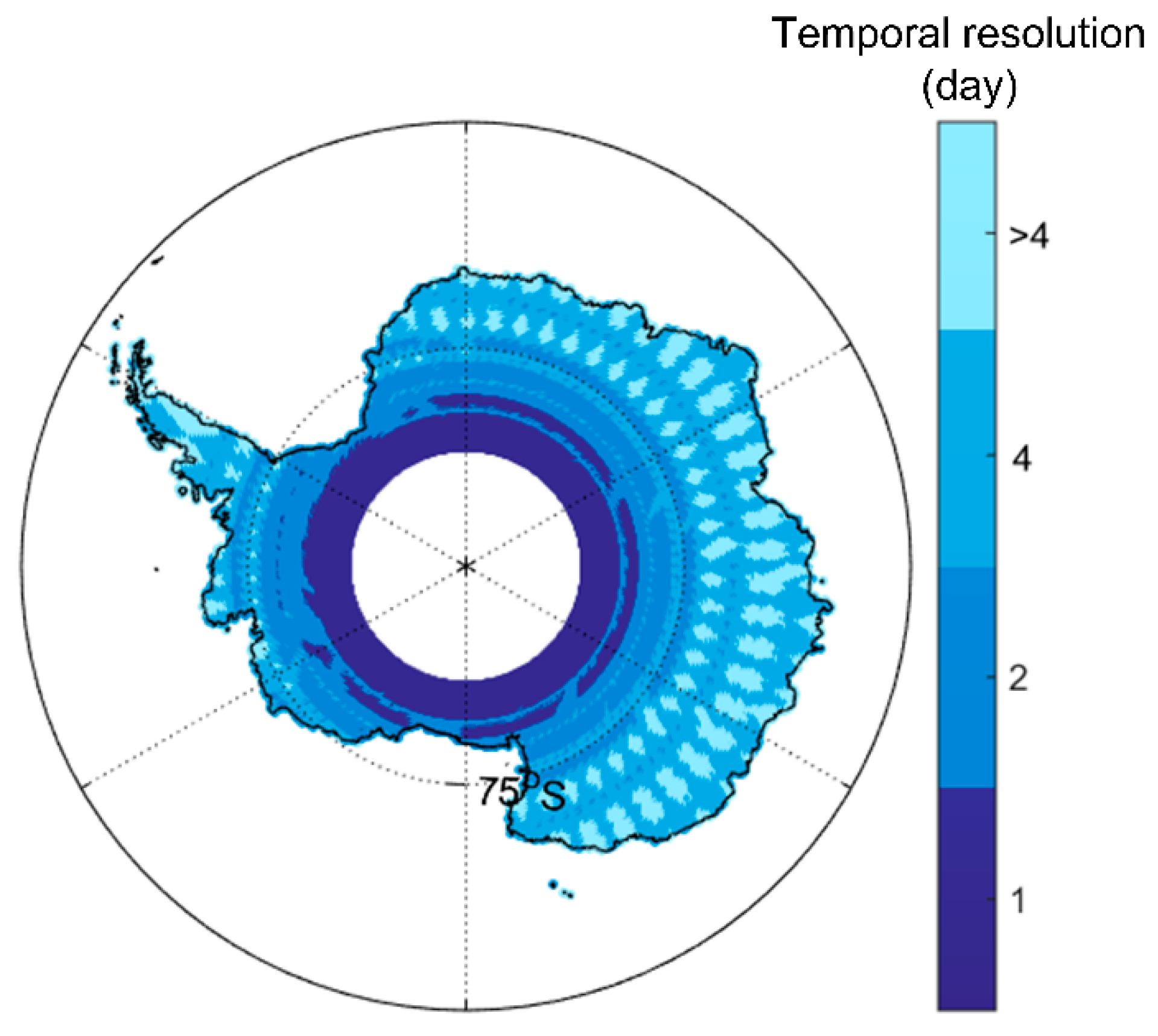
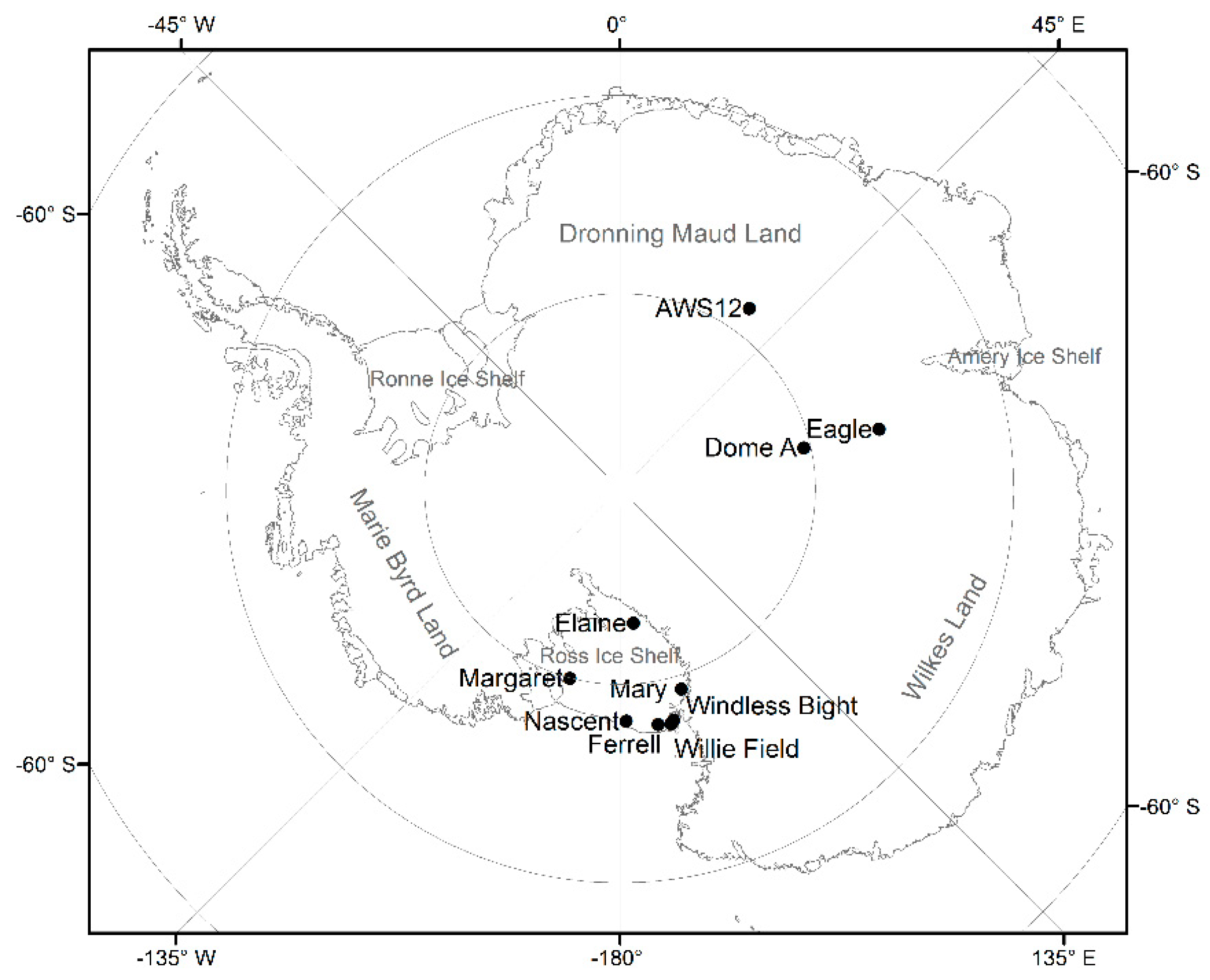
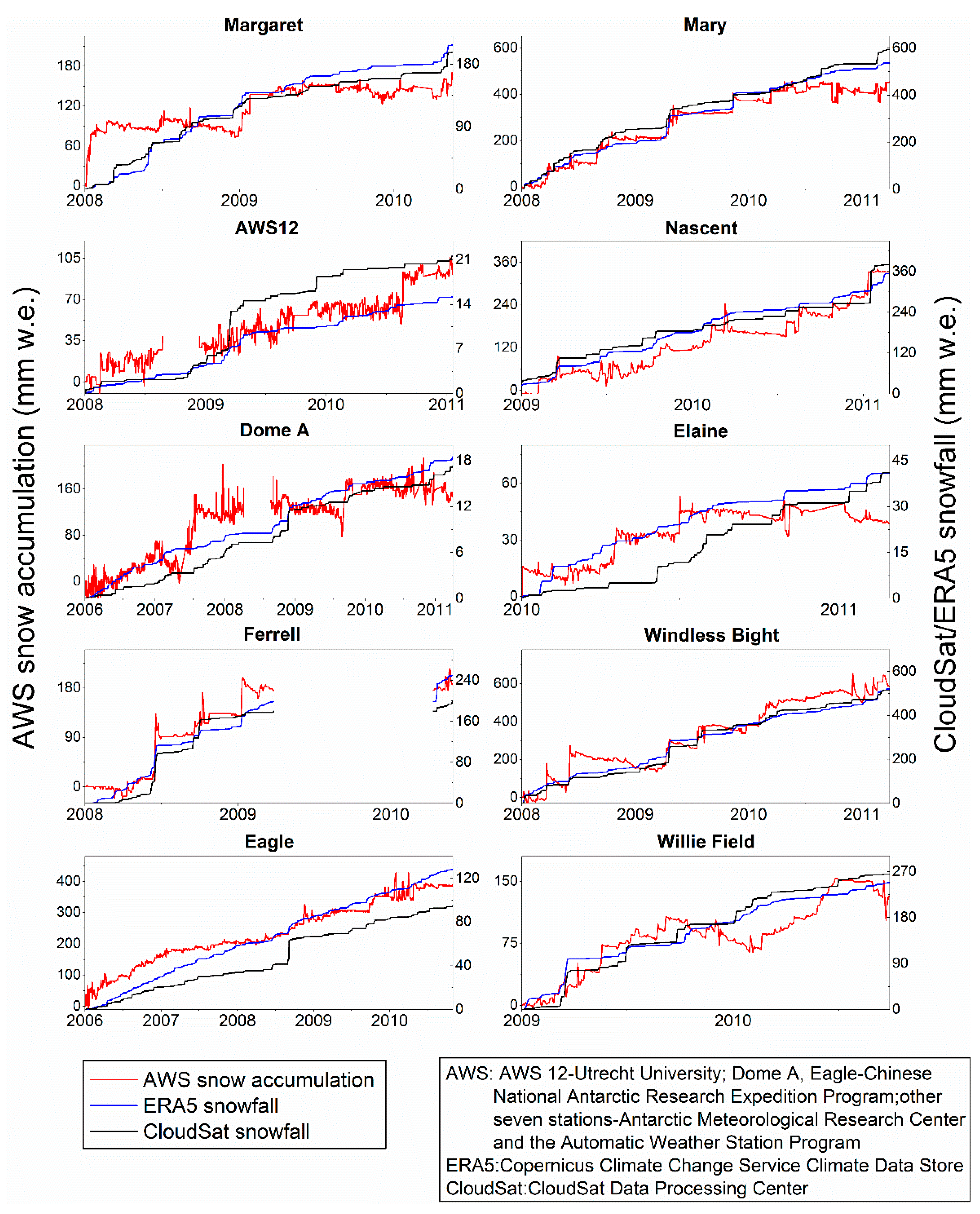
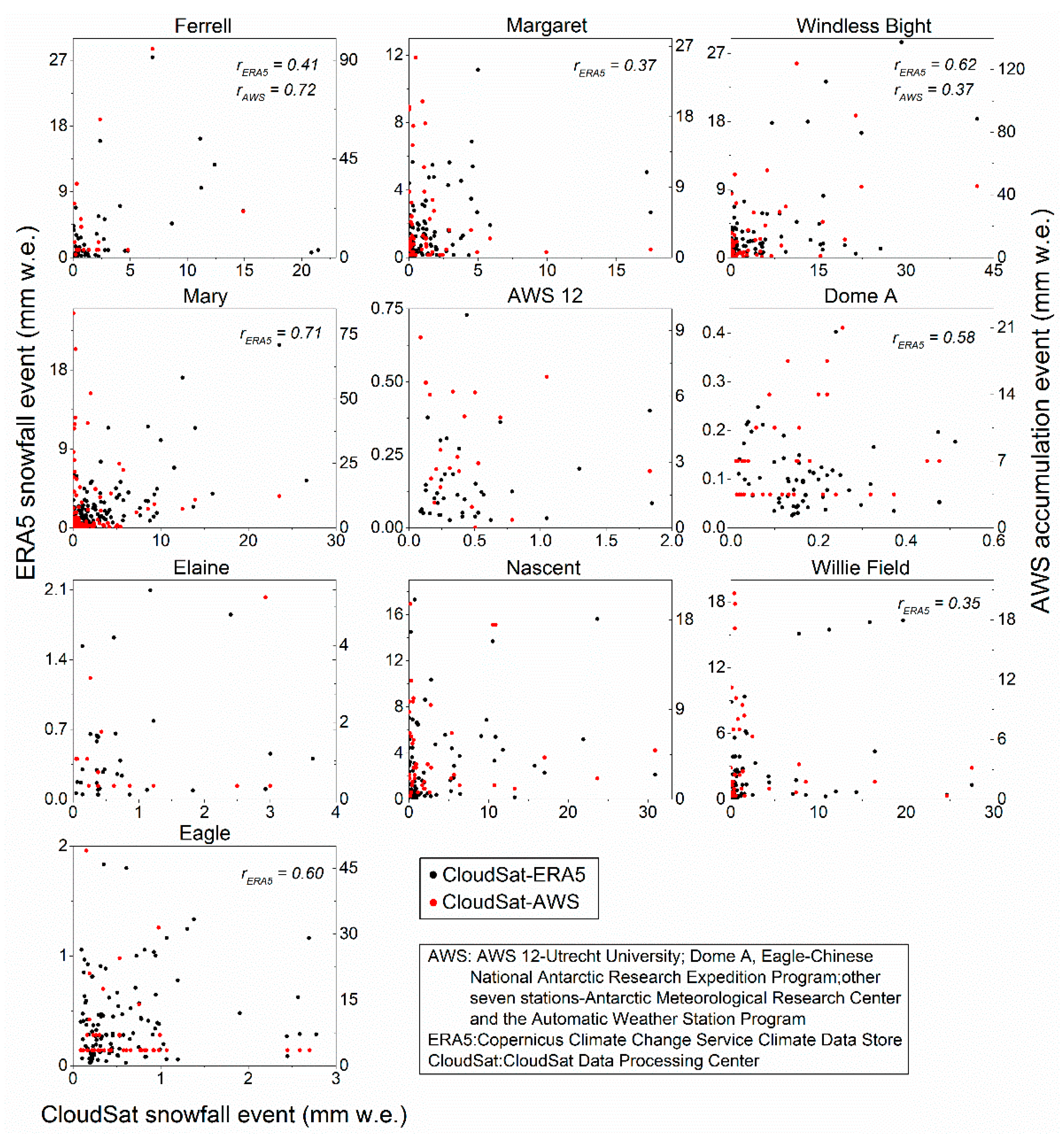
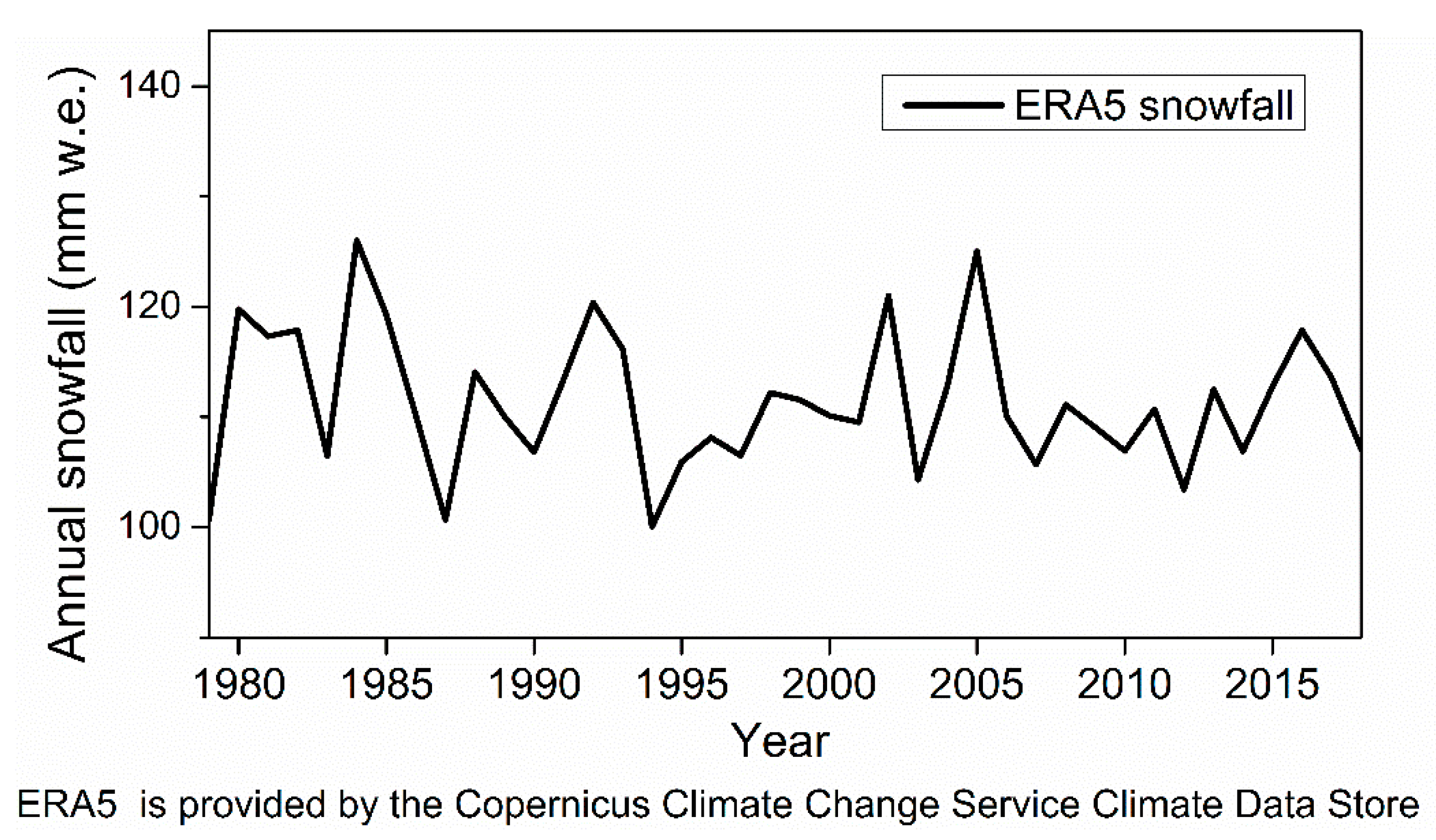
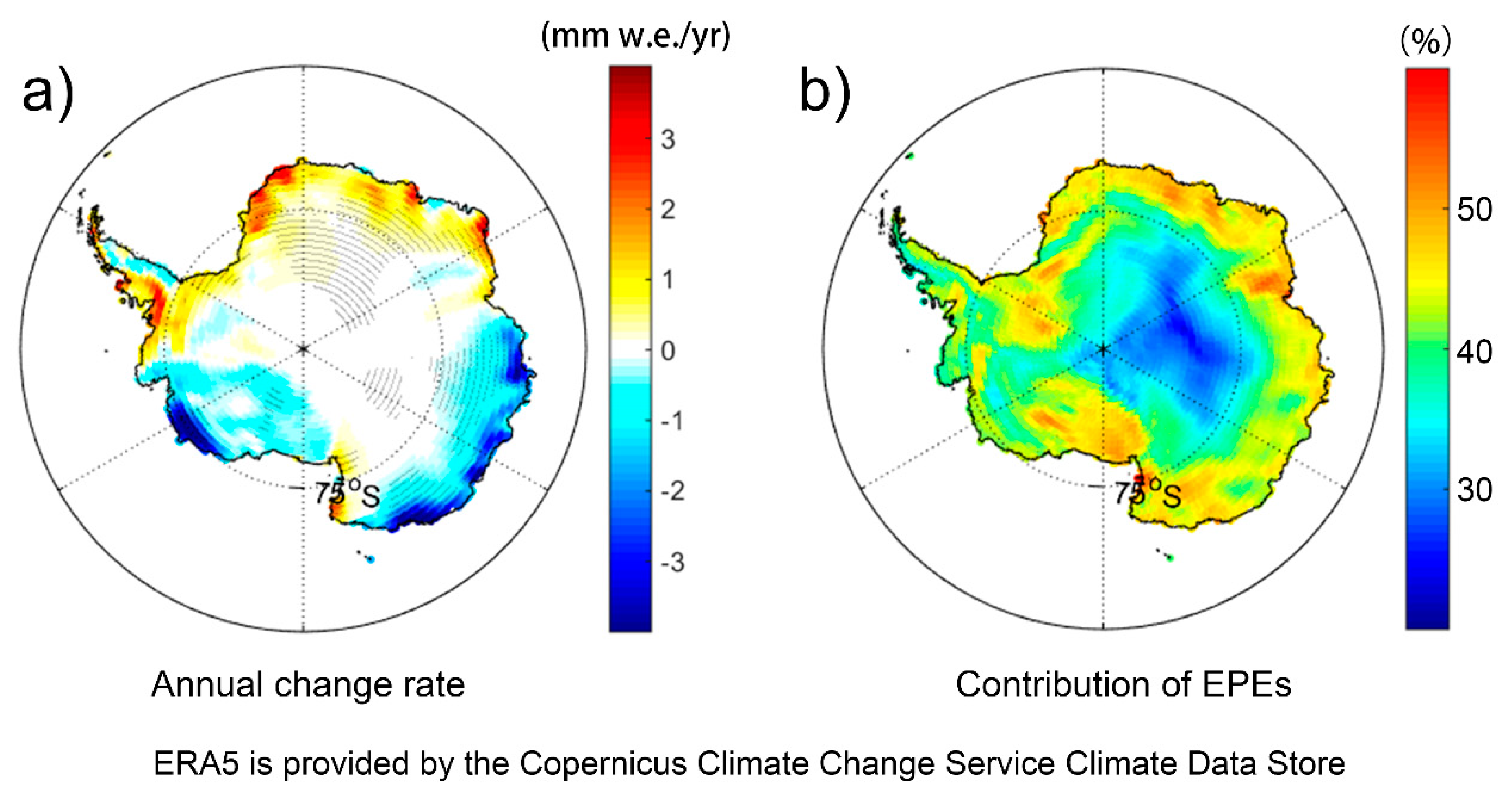
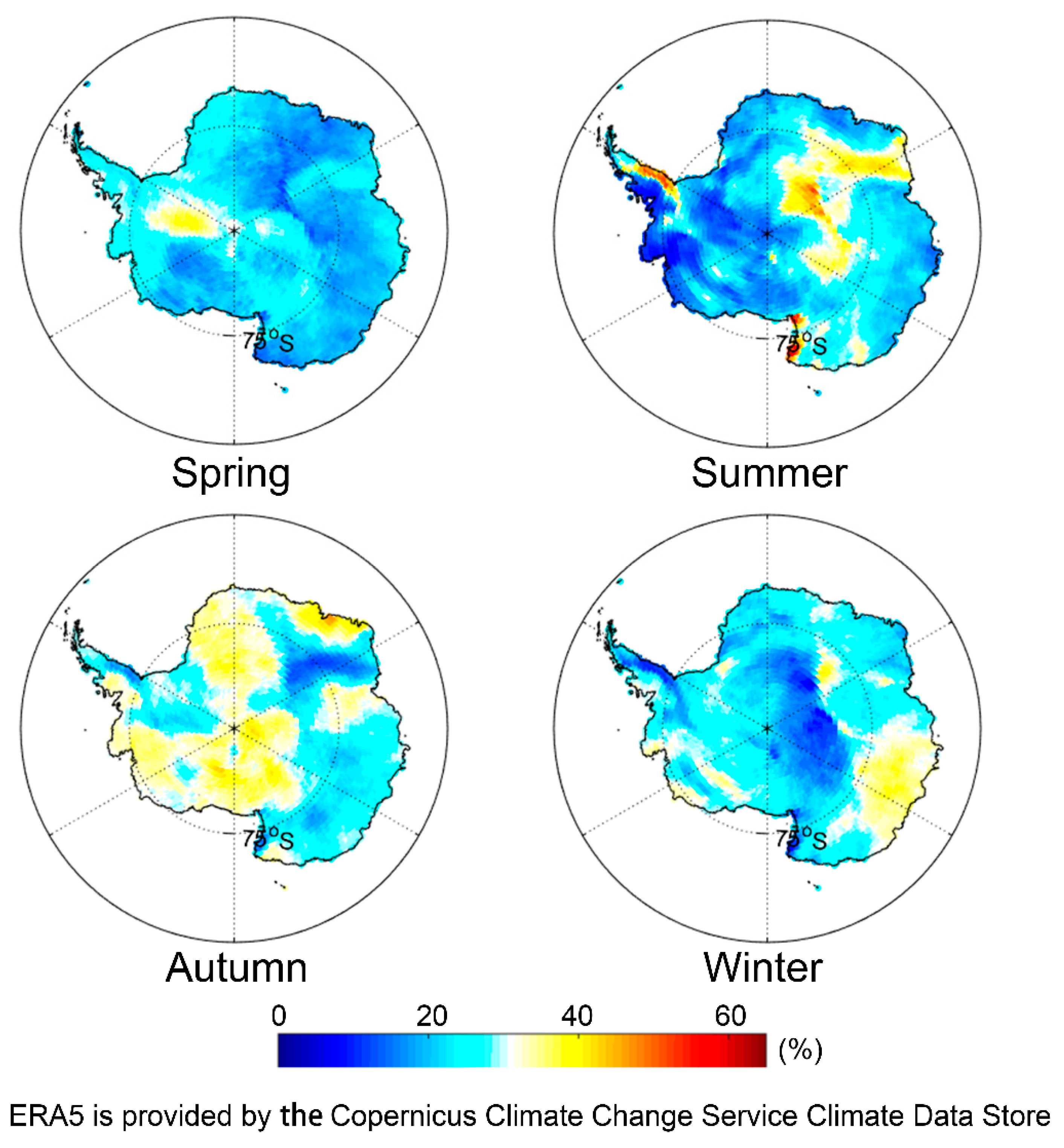
| Station | Longitude | Latitude | Date | Length (year) | Region | Elevation (m) |
|---|---|---|---|---|---|---|
| Margaret * | 165.099° W | 79.981° S | 1 November 2008–31 March 2011 | 2.4 | RIS | 67 |
| Mary * | 162.985° E | 79.305° S | 1 January 2008–31 March 2011 | 3.3 | RIS | 58 |
| Elaine * | 174.285° E | 83.094° S | 1 February 2010–31 March 2011 | 1.2 | RIS | 58 |
| Ferrell | 170.817° E | 77.803° S | 1 November 2008–31 March 2011 | 1.4 | RIS | 43 |
| Windless Bight | 167.687° E | 77.725° S | 1 January 2008–31 March 2011 | 3.2 | RIS | 40 |
| Willie Field | 166.947° E | 77.867° S | 1 February 2009–31 October 2010 | 1.7 | RIS | 12 |
| Nascent | 178.498° E | 78.129° S | 1 January 2009–31 March 2011 | 2.2 | RIS | 30 |
| AWS12 * | 35.633° E | 78.65° S | 1 March 2008–31 March 2011 | 3.1 | East Antarctica | 3620 |
| Eagle | 77.024° E | 76.42° S | 1 February 2005–31 March 2011 | 6.2 | East Antarctica | 2830 |
| Dome A * | 77.374° E | 80.367° S | 17 January 2005–31 March 2011 | 6.3 | East Antarctica | 4084 |
| Station | MAE | RMSE | MB | PD | SF-C | SF-E |
|---|---|---|---|---|---|---|
| (mm day−1) | (mm day−1) | (mm year−1) | (%) | (mm year−1) | (mm year−1) | |
| Margaret | 1.49 | 2.62 | −2.59 | 5.3% | 82.0 | 86.4 |
| Mary | 1.88 | 3.46 | −5.56 | −9.5% | 179.6 | 162.5 |
| AWS 12 | 0.35 | 0.52 | 14.11 | −29.2% | 17.9 | 12.7 |
| Dome A | 0.14 | 0.20 | 1.57 | 7.2% | 12.3 | 13.2 |
| Elaine | 0.67 | 1.07 | −0.21 | −0.6% | 12.8 | 12.8 |
| Ferrell | 3.12 | 6.02 | −12.89 | 26.0% | 116.6 | 146.9 |
| Windless Bight | 2.94 | 5.57 | −1.42 | 1.1% | 234.1 | 236.7 |
| Eagle | 0.54 | 1.49 | 8.39 | 35.3% | 30.5 | 41.3 |
| Nascent | 4.54 | 11.98 | 0.11 | −6.8% | 61.3 | 57.1 |
| Willie Field | 3.19 | 5.98 | 8.67 | −6.3% | 42.0 | 39.4 |
| Station | All Days | ESE–positive | non-ESE/non-positive | ESE– | ||||||
|---|---|---|---|---|---|---|---|---|---|---|
| ave | max | dir | ave | max | dir | ave | max | dir | wind | |
| (m s−1) | (m s−1) | (°) | (m s−1) | (m s−1) | (°) | (m s−1) | (m s−1) | (°) | (%) | |
| Margaret | 4.5 | 5.7 | 197.6 | 4.8 | 6.9 | 234.4 | 7.6 | 9.6 | 210.7 | 86.7 |
| Mary | 5.4 | 6.4 | 81.6 | 9.9 | 11.2 | 125.5 | 7.4 | 8.7 | 60.4 | 85.7 |
| Ferrell | 4.2 | 6.1 | 124.4 | 6.1 | 7.8 | 125.3 | 8.4 | 11.5 | 46.9 | 60.0 |
| Windless Bight | 2.8 | 4.2 | 152.4 | 5.8 | 7.4 | 90.1 | 5.4 | 7.5 | 193.6 | 80.0 |
| AWS12 | 5.7 | 6.7 | 177.2 | 6.9 | 8.6 | 138.0 | 5.7 | 7.1 | 154.5 | 80.0 |
| Dome A | 5.4 | 6.7 | 216.9 | 8.9 | 10.6 | 115.6 | 7.7 | 10.0 | 162.6 | 81.3 |
| Eagle | 8.2 | 10.1 | 241.4 | 8.9 | 11.5 | 253.3 | 9.3 | 12.3 | 227.9 | 78.6 |
| Elaine | 4.8 | 5.7 | 113.1 | 6.7 | 7.7 | 45.2 | 8.3 | 9.2 | 254.7 | 61.5 |
| Nascent | 6.2 | 8.5 | 167.9 | 7.9 | 11.0 | 235.3 | 7.8 | 10.8 | 191.9 | 70.0 |
| Wille Field | 2.9 | 4.4 | 154.4 | 4.0 | 5.6 | 272.2 | 5.1 | 6.6 | 113.9 | 60.0 |
| Station | ave | max | dir | EAE–none |
|---|---|---|---|---|
| (m s−1) | (m s−1) | (°) | (%) | |
| Margaret | 3.6 | 4.8 | 151.9 | 37.5 |
| Mary | 5.5 | 6.7 | 89.2 | 53.8 |
| AWS12 | 3.3 | 4.6 | 104.2 | 53.3 |
| Dome A | 4.8 | 6.2 | 20.6 | 37.5 |
| Elaine | 5.7 | 7.1 | 178.8 | 33.3 |
| Ferrell | 6.1 | 7.1 | 251.7 | 20.0 |
| Windless Bight | 10.2 | 12.2 | 259.8 | 10.0 |
| Eagle | 5.1 | 6.1 | 72.4 | 33.3 |
| Nascent | 2.9 | 4.0 | 64.4 | 14.3 |
| Willie Field | 4.5 | 6.7 | 35.4 | 27.3 |
| Station | CR-ERA5 | CR-CloudSat |
|---|---|---|
| Margaret | 63.2% | 51.1% |
| Mary | 64.8% | 57.8% |
| AWS12 | 74.0% | 21.1% |
| Dome A | 56.3% | 23.7% |
| Elaine | 67.4% | 29.0% |
| Ferrell | 75.0% | 39.1% |
| Windless Bight | 74.5% | 41.3% |
| Eagle | 88.5% | 24.7% |
| Nascent | 84.5% | 40.0% |
| Willie Field | 66.7% | 43.4% |
© 2019 by the authors. Licensee MDPI, Basel, Switzerland. This article is an open access article distributed under the terms and conditions of the Creative Commons Attribution (CC BY) license (http://creativecommons.org/licenses/by/4.0/).
Share and Cite
Liu, Y.; Li, F.; Hao, W.; Barriot, J.-P.; Wang, Y. Evaluation of Synoptic Snowfall on the Antarctic Ice Sheet Based on CloudSat, In-Situ Observations and Atmospheric Reanalysis Datasets. Remote Sens. 2019, 11, 1686. https://doi.org/10.3390/rs11141686
Liu Y, Li F, Hao W, Barriot J-P, Wang Y. Evaluation of Synoptic Snowfall on the Antarctic Ice Sheet Based on CloudSat, In-Situ Observations and Atmospheric Reanalysis Datasets. Remote Sensing. 2019; 11(14):1686. https://doi.org/10.3390/rs11141686
Chicago/Turabian StyleLiu, Yihui, Fei Li, Weifeng Hao, Jean-Pierre Barriot, and Yetang Wang. 2019. "Evaluation of Synoptic Snowfall on the Antarctic Ice Sheet Based on CloudSat, In-Situ Observations and Atmospheric Reanalysis Datasets" Remote Sensing 11, no. 14: 1686. https://doi.org/10.3390/rs11141686







